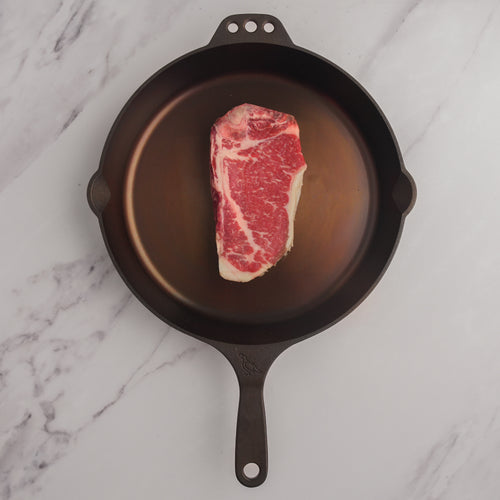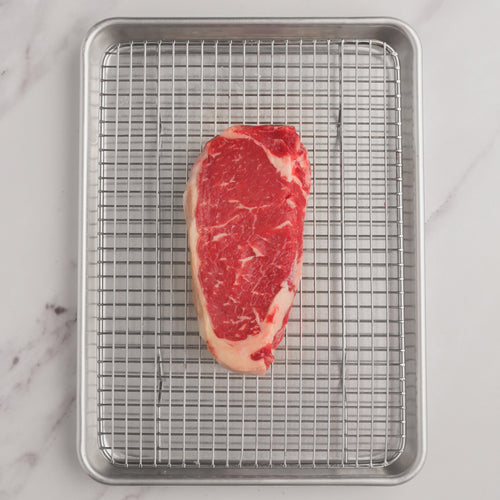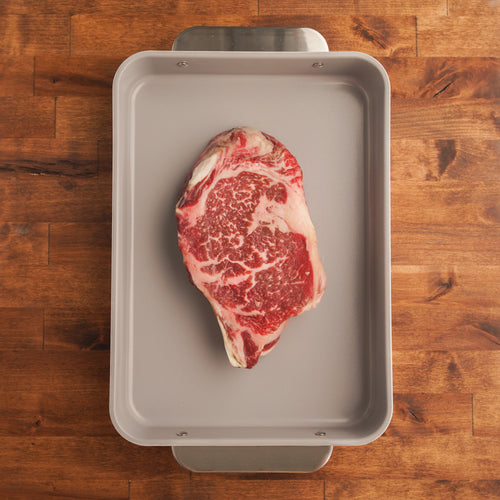
A Guide to Dry-Aged Beef
Sit down at a great steakhouse and you'll find a special section on the menu for dry-aged steaks. These are the premium selections which you’ll quickly notice also carry premium prices. Are dry-aged steaks really better? Why are dry-aged steaks more expensive? Let’s take a look at dry-aging, its benefits and what to expect from dry-aged beef.
What Is Dry-Aging?
Dry-aging is a process where beef rests in a controlled open-air environment. This is an ancient method to preserve beef that was utilized before the invention of refrigeration and dates back thousands of years.
The resting or aging process changes the beef in significant ways including flavor, aroma and tenderness. The final dry-aged steak is the result of moisture loss, as well the effects of enzymatic and bacterial action.
What Does Dry-Aging Do, Exactly?
Dry-aging is a method to preserve beef and is a form of controlled decay where natural enzymes break down muscle fibers. A properly dry-aged steak is more tender than a conventional steak.
A measurable component of dry-aging is the loss of water or moisture. It makes sense that a cut of beef allowed to rest uncovered will lose moisture. Over the course of 30 days, a subprimal cut can lose as much as 30% of its original weight.
This is one reason dry-aged steaks are more expensive. If you start with 10 pounds of beef and end up with 7 pounds, there is going to be an increased cost for the finished product. A positive result of moisture loss is the concentration of any natural flavors in the beef.
During the dry-aging process, the intramuscular fat retains more water than the muscle fibers. For this reason, well marbled cut are the best candidates for dry-aging.
Large subprimal cuts are dry-aged, not individual steaks. The environmental factors of air flow, humidity and temperature are controlled. The outside of the subprimal forms a dry layer of crust while the interior is preserved and develops rich flavor.
What Does Dry-Aged Steak Taste Like?
The primary reason people appreciate a dry-aged steak is the difference in flavor. The loss of moisture acts to concentrate the flavor components of beef. Natural enzymes and bacteria work to break down the muscle fibers and transform the flavor and texture of the beef.
When you take a bite of steak that’s properly dry-aged, it is very tender. The aroma is more pungent than a regular steak and takes on notes many have equated with buttered popcorn. It has a more concentrated beef flavor and if it’s been aged more than 60 days, the flavor profile develops distinct nutty flavors.
How to Cook Dry-Aged Steak
When it comes to cooking dry-aged steak, simplicity is key. Minimizing seasoning and technique highlights the concentrated beef flavor achieved through the dry-aging process. We recommend applying salt and pepper and preparing using the reverse sear method.
To cook a dry-aged steak, the steps are simple:
- Thaw your SRF Black® and SRF Gold® dry-aged steak completely in the refrigerator. Small steaks will thaw overnight. Large, thick steaks may require two days.
- Allow the steak to rest for 30 minutes outside the refrigerator to bring the meat closer to room temperature.
- Preheat your oven to 275°F degrees.
- Season the dry-aged beef with salt and pepper. Don’t forget to season the sides.
- Cover a baking sheet in foil and place the dry-aged steak on a metal rack atop the pan.
- Bake for up to 75 minutes, but begin to check the internal temperature of the steak starting around 30 minutes in.
- Pull the dry-aged steak from the oven when it reaches an internal temp of 120°F degrees if you prefer a rare doneness. For medium-rare, pull at 125°F degrees, and for medium do so at 130°F degrees.
- Get a carbon steel or cast iron skillet as hot as your stovetop can handle.
- Apply grapeseed, avocado oil, or your preferred fat to coat the pan.
- Lay the dry-aged steak away from you on the pan and sear each side for 60 to 90 seconds.
The Best Steaks to Dry-Age
The best dry-aged steaks start with top quality, deeply marbled beef. The cuts that naturally contain the most marbling are from the rib and short loin sections. Steaks from these areas include the ribeye, strip steak and Porterhouse. The ribeye category includes thick-cut, bone-in steaks like the tomahawk and bone-in rib steaks.
Premium steakhouses often menu dry-aged steaks that are USDA Prime, the USDA grade with the highest amount of marbling. USDA Choice ribeyes and strips, which contain higher levels of intramuscular fat are also good candidates for dry-aging.
Snake River Farms offers dry-aged steaks using USDA Prime , USDA Choice and American Wagyu beef. SRF Black® and SRF Gold® American Wagyu beef produce outstanding dry-aged steaks since both grades are rich with marbling above USDA Prime.
How Long to Dry Age Beef?
A very important factor is the amount of time the beef is aged. Most experts agree that 30 days is the minimum time for dry-aging to do its magic. Some facilities dry-age beef for 2 months or even longer.
Dry-aged products less than 30 days do not provide the enhanced eating experience of beef aged for a longer time.
The dry-age facility also plays a major role in finished quality.
Dry-Aged Wagyu Beef
The more intramuscular fat, or marbling, a cut of beef contains, the more flavor it will acquire from the dry-aging process. This is what makes Wagyu beef outstanding for dry-aging. Wagyu cattle are known for their incredible layers of intramuscular fat, and 30 days of dry-aging creates beef with a powerful and unforgettable flavor.
Dry-aged Wagyu beef is a unique eating experience that is worth trying. We’ve found it isn’t for everyone. The beefier, nutty qualities are not appreciated universally. However, for many, it is the ultimate steak and well worth the premium price.







